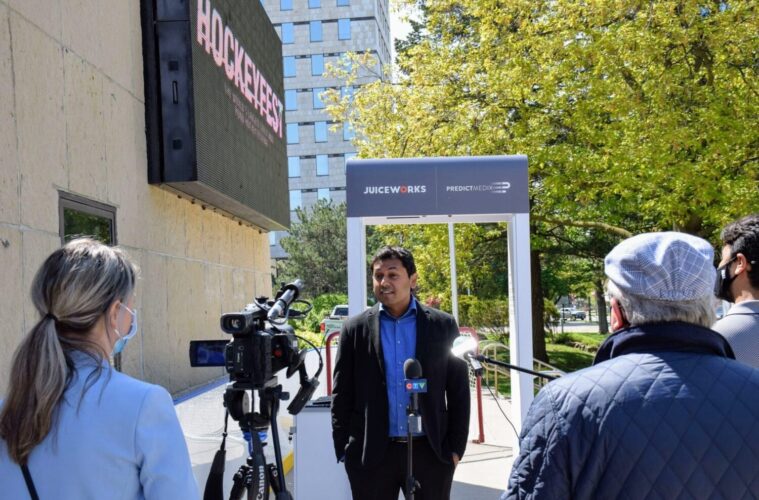Predictmedix Inc. may have the answer to squash concerns about stoned driving.
The lack of a validated mechanism to test someone’s level of impairment from cannabis use on the spot has complicated the national rollout. Regulators and elected officials vent their fears about stoned driving all the time. You can test someone’s saliva, urine, blood or hair, but these detection methodologies are too dated for the modern era. Mostly because they aren’t focused on the moment but whether you’ve used drugs over a more extended time frame that goes long after the impairment has stopped. If you were to base impairment on those tests, you would have a ton of false positives since more of the workforce are enjoying off-the-clock use and have those spent THC metabolites in their system.
The same people who don’t want to change drug testing laws to protect off-the-clock use are ironically well-versed in the reality of current testing not truly benefiting public safety in real time. But what if you could use artificial intelligence to determine someone’s level of impairment in 20 seconds?
Predictmedix calls itself an emerging provider of rapid health screening, medical devices, and remote patient care solutions globally. Over the last three years, the now publicly traded company has raised $3 million.
“And all that money has gone into developing the technology. And now we’re commercially deployed,” Toronto venture capitalist Steve Singh told L.A. Weekly. He went on to break down the difference between their tech and the breathalyzer tech that’s been in development for years. “With the breathalyzer and you get a result in 20 minutes that’s biased, with Rahul’s technology, it’s 20 seconds and unbiased.”
The Rahul that Singh mentioned is Dr. Rahul Kushwah who founded Predictmedix after leaving academia to pursue AI-based impairment testing. To date, 50,000 people have now been screened by his Safe Entry Stations at places like The Super Bowl and F1 races.
The stations are powered by a proprietary AI. It uses multispectral cameras to analyze physiological data patterns with its screening technology to detect many conditions. They include cannabis or alcohol impairment, infectious diseases, mental illness, Alzheimer’s, Parkinson’s, respiratory illnesses, COVID 19, and signs of fatigue. The stations are about 90% accurate. Kushwah told LA Weekly that the tech still had trouble with people under the age of 18 and over 75. If you were to remove those groups from the data pool, he estimates the accuracy would be well over 95%.
“It’s almost like we have developed this new language. With this language, you can write impairment, you can write fatigue. You can write health care parameters, screening for diseases, whatever you want. So effectively, we have a platform that can be used to screen an unlimited number of things,” Kushwah said.
We asked Kushwah how helpful it is to have the road out in front of them with no real sign of another mechanism to test a person for their current level of cannabis impairment in the near future.
“So let’s say we talk about cannabis impairment. First of all, this whole concept of using breathalyzers for cannabis just cannot work from a scientific perspective because the only time you can make a freaking correlation is if you can measure the level of THC in the brain,” Kushwah replied. “The THC has to cross the blood-brain barrier to impair you in the first place. So that’s why we’re not even going after measuring THC. What we’re identifying are signs of impairment.”
Kushwah went on to explain, Predictmedix can actually create thresholds in terms of what you want to define as impairment within your organization. If it’s zero tolerance, they can make it that way in the Safe Entry Stations. The red light is going to come on, even if somebody is showing just the slightest signs of impairment.
Since launching the Safe Entry Station, Predictmedix has worked to scale down the machines to something a bit more manageable. They’ve not reached the point where they’ll release a phone app that pairs with a small multispectral camera you plug into your phone.
“You put the camera in front of you, you look at the camera, you say a few sentences that are popping up on your phone and that’s it, and that can be used to identify impairment in 10 to 15 seconds,” Kushwah said.
Kushwah explained the reason for using multispectral imaging is because they don’t really care about how you look on top of your skin. He argues there is no such thing as looking stoned.
“It’s more about, how are the changes in the underlying blood flow patterns that we are able to identify. And that’s part of the reason that our technology, I mean, is a bit Star Trek in a way. I mean, just think about it. Not only the technology can tell you if you’re impaired if you’re fatigued, but it can also tell you your heart rate, breathing rate, temperature and a lot of your vitals, without even touching you,” Kushwah said. “ And we have completed a few clinical studies in different parts of the world where we have had medical institutions basically signing off on our technology and saying how this is the future and the future is now.”
The app could certainly be a game changer. Imagine police officers being able to give people impairment tests without even getting out of their cars. If they fail, they can do a full sobriety test that would confirm the test or catch a false positive
We’ll continue to keep an eye on how this plays out.
Advertising disclosure: We may receive compensation for some of the links in our stories. Thank you for supporting LA Weekly and our advertisers.

